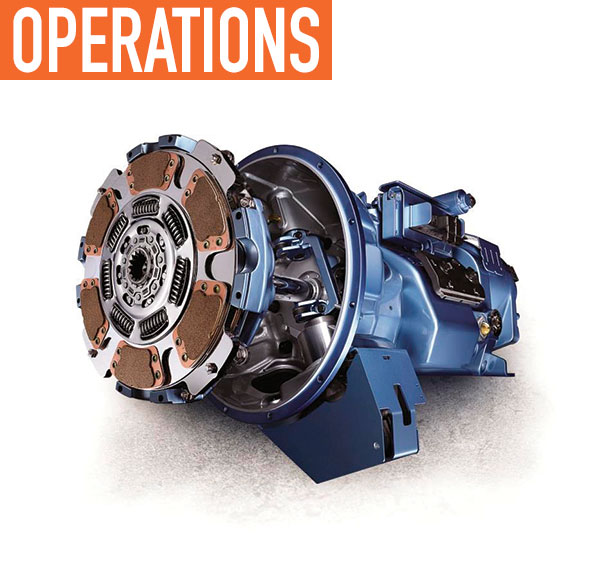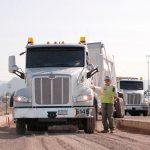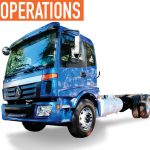It’s no secret that vocational drivers spend a significant amount of time on the road. It is for this reason some companies create products targeting driver comfort and/or driver convenience. One such company is Eaton, a power management company that provides energy-efficient solutions to help customers effectively manage electrical, hydraulic, and mechanical power.
LOW-SPEED, INCREASED MANEUVERABILITY
Eaton recently added two low-speed features to its UltraShift PLUS and Fuller Advantage automated manual transmissions. These features—Blended Pedal and Urge to Move—allow the driver to have more control in low-speed applications, such as maneuvering around jobsites and backing into loading docks. While Blended Pedal gives drivers manual transmission-operating performance in a two-pedal automated system, Urge to Move allows the vehicle to move while in gear with release of the service brake.
There’s more to the UltraShift PLUS than its optional low-speed features; it also comes equipped with thermal protection. “We’re allowing customers on an automated platform, for the first time, to manipulate the clutch without using a clutch pedal as a higher reliability option. There is less risk of clutch burnout, because of the protection built into our automation package. You wouldn’t have that on a manual transmission,” says Evan Vijithakumara, product strategy manager for Eaton’s heavy-duty vocational portfolio.
This type of transmission upgrade provides driver advantages. “The product can do what the driver needs it to do and in a much easier fashion. Instead of taking a driver two tries to do something, with the new features it can only take one try,” says Nick Jelen, systems engineer, Eaton.
“To get the safety and fuel economy benefits of automation, in the past, you had to make some compromises on fine levels of control and precise movement capabilities. With these new features, Blended Pedal and Urge to Move, we can eliminate compromises and add greater value for our customers,” says Vijithakumara. The addition of these low-speed features allows drivers to be task-focused, increasing safety; it also allows for maximum maneuverability with minimal effort, increasing driver convenience.
MOTIVATION FOR CHANGE
“What does the driver need?” is an innovation-provoking question. This was the case with Blended Pedal and Urge to Move. “In the process of thinking through how to optimize our performance to better serve our customers, we sent engineers out with our Roadranger team to benchmark a number of fleets and drivers. From this, we refined our understanding of the unique tasks our customers perform with their trucks in real-world applications. This helped us define what our positives and negatives were and, in the process, enabled the development of new modeling techniques and new strategies for controlling our products,” explains Vijithakumara.
“One of the key differentiators we thought through was how to extend the level of control available with our manual products across a broader pool of customers in the vocational space. We were looking for a step change in the maneuverability of our automated products to let our customers enjoy that manual style control, that fine level of control, alongside all the modern safety features baked into our latest and greatest generation heavy-duty platforms,” Vijithakumara continues.
“About a year and a half ago,” explains Jelen, “engineers started visiting customers’ jobsites to get a feel for how they were using their vehicles and what drivers were not doing as well that they needed to be able to do differently. A lot of research activity was focused on discovering what needed to change to better support vocational customers with very specific needs. We used this discovery phase to see what needed to change, what wasn’t working, and what was working.”
FRUITS OF LABOR
While Blended Pedal and Urge to Move haven’t been on the market long, the features are making an impact. “Within the first two months of deployment, we reached about 1,000 trucks on the road with these new features,” says Vijithakumara.
To get a feel for how these features are faring in real-world applications, it is important to understand the methodology that went into bringing them to life in the first place. “We’ve pursued multiple opportunities to receive feedback on these features throughout the entire process, from early test and trial phases of prototype software with customers that we invited into our own facilities to going out to fleets with our own trucks to demonstrate the prototype software on their home turf,” Vijithakumara continues. “Then deploying folks out again when we had certified software available for configuration on customer trucks for the very first time.”
The method implemented in creating Eaton’s low-speed features left little need for value engineering. “We did a lot of bringing the customer to us in the early concept phases. That was very beneficial, because it filled in holes and gaps before we were ready to hit public roads. The way fleets talked with us about their product needs and how their trucks were being used gave us a lot to work with as to what the features needed to do and what the drivers were expecting,” says Jelen.
After the initial in-house passes, the Eaton team took the product out for a test drive. “We went out twice and, each time, we put the features on 30 or so trucks. From the initial feedback, we found a couple of things that the drivers wished the features did a little differently,” continues Jelen. “For the most part, the feedback was positive. This was mainly because we had a lot of initial feedback baked in from bringing customers to our site first.”
AND THAT’S HOW IT’S DONE
From concept to completion, customer input was essential for creating Blended Pedal and Urge to Move. “We allowed the feedback to lead us down this path,” says Vijithakumara. “What’s unique about how we’re approaching low-speed on our platform with these new features is the power of choice. With these two features, Blended Pedal and Urge to Move, we now have the ability to flexibly offer customers two new ways to achieve low-speed control with even higher levels of precision.”![]()
FOR MORE INFORMATION:
Find out more about Eaton’s low-speed features and other Eaton products and services, visit www.roadranger.com.
_______________________________________________________________________
MODERN WORKTRUCK SOLUTIONS: JANUARY 2016 ISSUE
Did you enjoy this article?
Subscribe to the FREE Digital Edition of Modern WorkTruck Solutions magazine.
![]()




